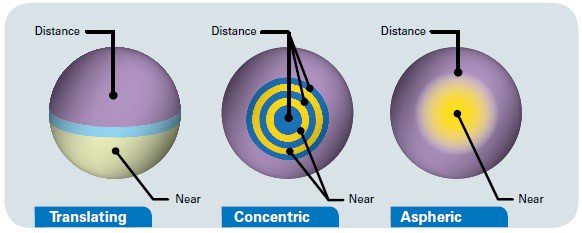Multifocal contact lenses
Multifocal contact lens designs are an option offered to people who have developed a condition called presbyopia. Presbyopia makes us gradually lose the ability to focus clearly on close objects.

Multifocal contact lens designs are an option offered to people who have developed a condition called presbyopia. Presbyopia makes us gradually lose the ability to focus clearly on close objects. The very first sign of developing presbyopia, is that you need to hold reading material farther away in order to see it clearly. If you are presbyopic you are not alone. Eventually, almost everyone is, the average age of presbyopia to occur is 44. The most common complain of people who develop presbyopia is having to put on and take off their reading glasses all day long. Switching between distance glasses and reading glasses is even more annoying. Reading glasses must be carried everywhere and is not uncommon to having to own several pairs of reading glasses for different areas of the house or workplace since reading glasses are often misplaced or forgotten.
Multifocal contact lenses feature innovating optical designs which allow you to see clearly at all distances: distance (driving), intermediate (computer work) and near (reading). This basically happens because a range of prescription powers blend across the contact lens and this blending works with your eyes’ natural function for uninterrupted clear vision from far away to close up.
Multifocal contact lenses have gradually replaced bifocal contact lenses. The later type has been around for many years but was not very popular since older designs didn’t satisfy many people. However, new technology has produced more successful and actually a variety of multifocal lens designs. Multifocal contact lenses come in rigid but most commonly in soft contact lens materials. Some manufacturers offer monthly soft multifocal lenses made of silicone hydrogel material and even daily soft multifocal contact lenses. Silicone hydrogel materials allow significantly more oxygen to reach the cornea for greater wearing comfort and daily multifocal contact lenses provide the convenience of throwing the lenses away at the end of each use without having to care for them in solutions and cases. You just replace them with fresh, new lenses next time you need them (please also see page dedicated to soft contact lenses).
A multifocal contact lens has a range of powers incorporated in it. There are mainly two different groups of multifocal contact lens designs which work in different ways:
1) Alternating vision or Translating multifocal design:
This design is similar to the bifocal and multifocal spectacles available currently as the bottom portion of the lens is for near vision and the top portion of the lens is for distance vision. This means that your pupil alternates between the two powers as your gaze shifts upward or downward. The Alternating vision design is used only in rigid gas permeable materials.
2) Simultaneous vision multifocal design:
The simultaneous vision multifocal design incorporates the near and distant vision portions of the lens in front of the pupil at the same time. This makes the brain to have to determine which parts of the lens to use to get the best image resolution. Although this might sound confusing, your visual system learns to select the correct power choice depending on how close or far you are trying to see.
Take care of your eyes as you will never get another pair!

Simultaneous vision multifocal lenses come in two types:
- Concentric ring multifocal designs
This type features a prescription in the center and one or more rings of power surrounding it. If there are multiple rings, they alternate between the near and distance prescription. Soft concentric multifocal designs are usually ‘center near’, that means that they usually have the near power in the center of the pupil. This central near vision circle, is surrounded by a larger circle that contains the distance vision correction. This can occur the other way round so a ‘center distance’ design will have the distance correction in the center and the near correction will be the outer ring surrounding it. In general, at least two rings are within your pupil area, but this varies as your pupil dilates and constricts due to varying light conditions.
- Aspheric multifocal designs
This type resembles progressive spectacle lenses because the different prescriptive powers are blended across the lens. However, aspheric multifocal contact lenses, unlike multifocal spectacle lenses, are simultaneous vision lenses, so your visual system must learn to select the correct prescription power depending on where you look at. This type of multifocal contact lens has actually become the most popular and is the only one which can be described as ‘progressive’.
Alternative contact lens options for people who have presbyopia:
What we optometrists call Monovision, is the most popular technique of correcting presbyopia with contact lenses without the use of multifocal lens designs. Monovision can be both used in shortsighted and longsighted people. It simply involves correcting your dominant eye for distance and your non-dominant eye for near. Monovision can be offered with either soft or rigid contact lens materials. Even though it compromises depth perception, it is well tolerated by most contact lens wearers. One advantage of the monovision technique is that single vision lenses are used for this technique so these are less costly to replace, lowering your annual contact lens expenses. Multifocal contact lenses are more expensive than single vision contact lenses due to the increased complexity in their design.
Modified monovision techniques may also be considered for specific wearers depending mainly on their lifestyle, and these techniques involve the fitting of a multifocal contact lens in one eye and a simple single vision contact lens in the other eye.
As there are various different multifocal designs offered by different manufacturers, different factors will be considered by your optometrist (like your prescription and your pupil size) in order for the the most appropriate design to be chosen for you. Complimentary trial contact lenses will be provided in order for you to be able to try your multifocal contacts in your daily routine and even workplace environment before choosing the final contact lens solution that is best for your daily visual needs.


